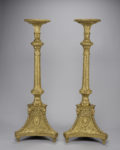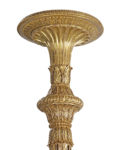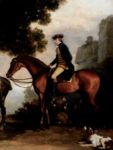 A pair of five-foot torchères made by iconic cabinetmaker Thomas Chippendale that witnessed some of the juiciest scandals of the Georgian era have entered the collection of the Cleveland Museum of Art and are now on display there. The museum acquired the candle-holders for $640,000 in a July sale of Thomas Chippendale works at Christie’s London. The seller was Washington D.C. collector S. Jon Gerstenfeld who had owned them since 1995. In the 220 years before then, the giltwood torchères illuminated the sexy goings-on at Brocket Hall in Hertforshire.
A pair of five-foot torchères made by iconic cabinetmaker Thomas Chippendale that witnessed some of the juiciest scandals of the Georgian era have entered the collection of the Cleveland Museum of Art and are now on display there. The museum acquired the candle-holders for $640,000 in a July sale of Thomas Chippendale works at Christie’s London. The seller was Washington D.C. collector S. Jon Gerstenfeld who had owned them since 1995. In the 220 years before then, the giltwood torchères illuminated the sexy goings-on at Brocket Hall in Hertforshire.
Of columnar form with finely carved acanthus leaves, swags, fluting, and oval masks depicting the Roman goddess Diana, these remarkable works exhibit Chippendale’s masterful understanding of neoclassical proportion, scale, and ornament. Monumental in size, they were designed in 1773 for the grand drawing room of Brocket Hall in Hertfordshire, England, the county seat of Sir Peniston Lamb.
Thomas Chippendale is perhaps best known for his landmark book of furniture designs, The Gentleman and Cabinet-Maker’s Director (first published in 1754), which was highly admired and widely used as a source of inspiration by cabinetmakers and architects in both Europe and America. As such, Chippendale is most often associated with the many works in mahogany or walnut that follow his designs. These torchères are among the very few pieces made by the master himself and are therefore considered exceedingly rare.
 Originally part of a set of four (the other pair were sold separately in 1994), the candle holders adorned a room that was already replete with Chippendale furnishings. The estate of Brocket Hall was purchased in 1746 by Matthew Lamb, a wealthy barrister and Member of Parliament who would be enobled nine years later and created 1st Baronet of Brocket Hall. In 1760 he built the stately neoclassical mansion that stands today. The Grand Saloon, a banquet hall built sparing no expense to make it fine enough to receive royalty, was filled with furniture custom-made by Thomas Chippendale. This room alone cost £1,500, the price to construct an entire mansion at that time.
Originally part of a set of four (the other pair were sold separately in 1994), the candle holders adorned a room that was already replete with Chippendale furnishings. The estate of Brocket Hall was purchased in 1746 by Matthew Lamb, a wealthy barrister and Member of Parliament who would be enobled nine years later and created 1st Baronet of Brocket Hall. In 1760 he built the stately neoclassical mansion that stands today. The Grand Saloon, a banquet hall built sparing no expense to make it fine enough to receive royalty, was filled with furniture custom-made by Thomas Chippendale. This room alone cost £1,500, the price to construct an entire mansion at that time.
When his father died in 1768, Peniston Lamb acceded to the baronetcy and became the master of Brocket Hall. He married Elizabeth Milbanke in April of 1769 and significantly boosted by her beauty, charm and facility for making friends and lovers at the highest levels of English society, Lord and Lady Melbourne quickly advanced socially and politically. The fact that less than a year after their marriage Lord Melbourne was already cavorting with an actress better known for her private performances posed no obstacle.
 The actress in question, Sophia Baddeley, wrote in her memoirs (published under the pseudonym Elizabeth Steele in the voice of a faux roommate following “as told to” convention) about Lord Melbourne’s pursuit of her.
The actress in question, Sophia Baddeley, wrote in her memoirs (published under the pseudonym Elizabeth Steele in the voice of a faux roommate following “as told to” convention) about Lord Melbourne’s pursuit of her.
This gentleman was about twenty-one years of age, and had been married about ten months to a very amiable woman. For a length of time, he used every means to engage her [Sophia’s] attention at Ranelagh, but finding that an improper place for an interview, at least such a one as he wished, he applied to a friend, in confidence, to make her, in his name, an offer of share in his fortune, in exchange for the possession of her heart. This friend brought her a letter, including a bill for 300£. which he very politely pressed her acceptance of, as a bagatelle, and to consider it only as a proof of his esteem, and that liberality which his affection for her would study to convince her of.
 Sophia of course nobly declined this offer on the grounds that Lamb should pay all this attention and consideration to his lovely wife, not her. He redoubled his efforts and next thing you know, they were found together “drinking tea,” her memoirs would have it. Melbourne “threw up the parlour window, and precipitately leaped out.” My, such a guilty reaction for someone caught in the innocuous act of sipping tea. Oh and, just out sheer politeness, I’m sure, “as an atonement for his intrusion,” Melbourne “left bank notes on the parlous table, to the amount of two hundred pounds.”
Sophia of course nobly declined this offer on the grounds that Lamb should pay all this attention and consideration to his lovely wife, not her. He redoubled his efforts and next thing you know, they were found together “drinking tea,” her memoirs would have it. Melbourne “threw up the parlour window, and precipitately leaped out.” My, such a guilty reaction for someone caught in the innocuous act of sipping tea. Oh and, just out sheer politeness, I’m sure, “as an atonement for his intrusion,” Melbourne “left bank notes on the parlous table, to the amount of two hundred pounds.”
 Lady Melbourne was no slouch in the extramarital activities department. She caught the eye of the Prince of Wales, the future King George IV, when she was in her early 30s, had been married for a decade and was in an active relationship with George Wyndham, 3rd Earl of Egremont, widely believed to be the father of her second son William, the future Lord Melbourne, who would find himself notoriously cuckholded when his wife, Lady Caroline Lamb, had a scandalous affair with Lord Byron. She famously had (Lady Melbourne hated her daughter-in-law but was a friend and confidant to Byron even during the intensely public affair that so humiliated her son. Byron would later marry her niece.)
Lady Melbourne was no slouch in the extramarital activities department. She caught the eye of the Prince of Wales, the future King George IV, when she was in her early 30s, had been married for a decade and was in an active relationship with George Wyndham, 3rd Earl of Egremont, widely believed to be the father of her second son William, the future Lord Melbourne, who would find himself notoriously cuckholded when his wife, Lady Caroline Lamb, had a scandalous affair with Lord Byron. She famously had (Lady Melbourne hated her daughter-in-law but was a friend and confidant to Byron even during the intensely public affair that so humiliated her son. Byron would later marry her niece.)
MP and historian Sir Nathaniel Wraxall wrote about her in his posthumous memoirs:
“A commanding figure, exceeding the middle height, full of grace and dignity, an animated countenance, intelligent features, captivating manners and conversation; all these, and many other attractions, enlived by coquetry, met in Lady Melbourne. Her husband had been principally known by the distinguished place that he occupies in the annals of meretricious pleasure, the memoirs of Mrs. Bellamy or Mrs. Baddeley, the syrens and courtesans of a former age.
The annals of meretricious pleasure were surely illuminated by the Chippendale torchères. The Prince of Wales was a frequent vision to Brocket Hall where he enjoyed the liberal hospitality of the lady of the house without complaint from its lord. And what did have to complain about when there was so much benefit to be had from his wife’s liaisons with the highest aristocracy in the land? Melbourne’s irrelevance in Parliament and penchant for ladies of ill-repute were no barrier to advancement. In 1770, he was made an Irish Baron. In 1781 he got bumped up to Viscount (also Irish) and in 1784 he was appointed Gentleman of the Bedchamber to his Royal Highness, who was (not coincidentally) entertaining Lady Melbourne in that bedchamber at the time. In 1815, during the Regency of the Prince, Melbourne got the boost all the way up the Peerage ladder when he was created Baron of the United Kingdom.